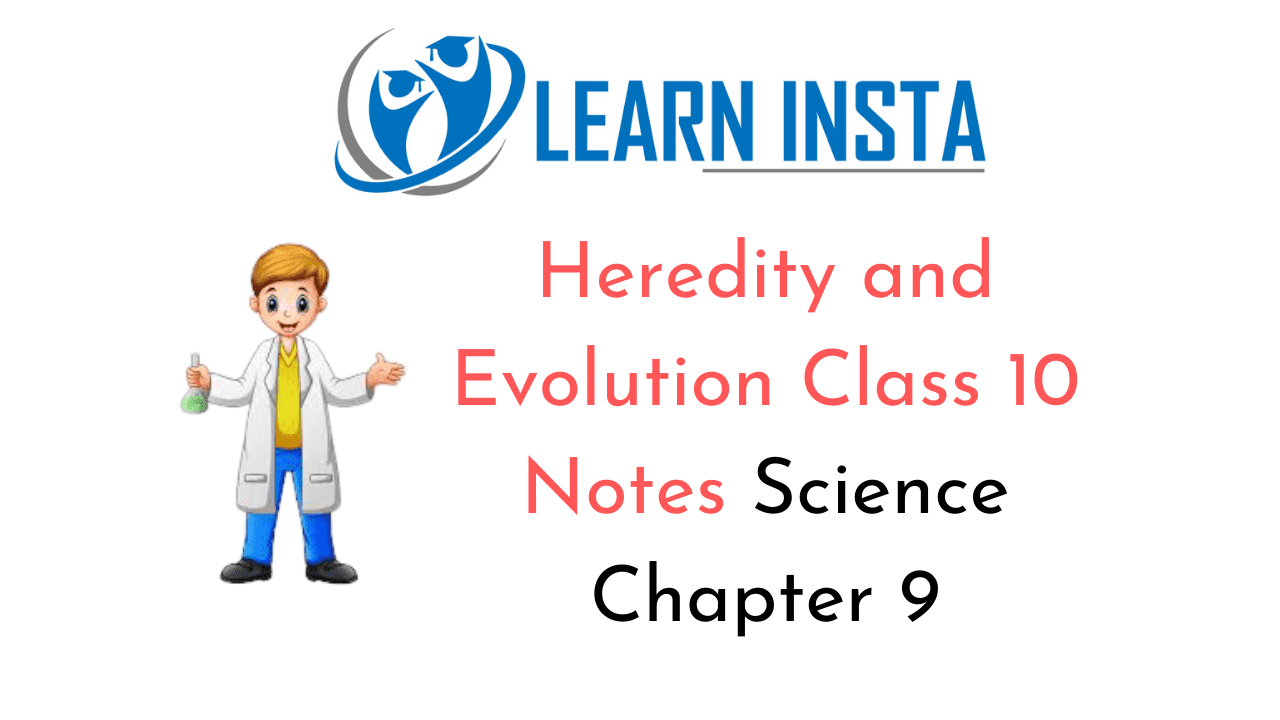 On this page, you will find Heredity and Evolution Class 10 Notes Science Chapter 9 Pdf free download. CBSE NCERT Class 10 Science Notes Chapter 9 Heredity and Evolution will seemingly help them to revise the important concepts in less time.
On this page, you will find Heredity and Evolution Class 10 Notes Science Chapter 9 Pdf free download. CBSE NCERT Class 10 Science Notes Chapter 9 Heredity and Evolution will seemingly help them to revise the important concepts in less time.
CBSE Class 10 Science Chapter 9 Notes Heredity and Evolution
Heredity and Evolution Class 10 Notes Understanding the Lesson
1. Heredity: Transmission of characters/traits from parents to their offspring. Variation: The degree by which progeny differ from their parents.
2. Genetics: The branch of science which deals with the study of heredity and variation.
3. Inheritance: It is the process by which characters are passed on from parent to progeny.
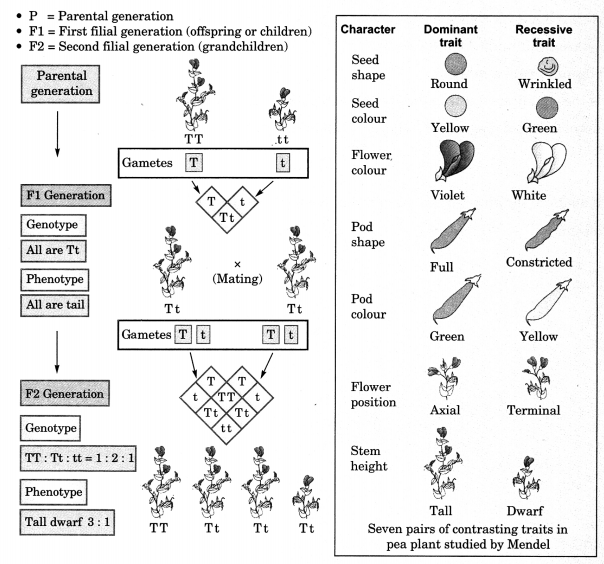
4. Gregor Mendel and his Contributions: Mendel is called as the Father of genetics. Mendel used a number of contrasting characters for garden pea. The seven pairs of contrasting characters taken by Mendel in garden pea are given in the figure.
5. Monohybrid Cross: Cross between two pea plants for one pair of contrasting trait of a character. Example: Tall/Short Plants for Stem height. Results of Monohybrid Cross for the character Height
6. In monohybrid cross for character height; Mendel crossed a homozygous tall pea plant (TT) with a homozygous dwarf pea plant (tt) to obtain all heterozygous tall pea plants (Tt) in the F1 generation. On selfing the heterozygous pea plants (Tt) obtained in the F1 generation, he obtained F2 progeny which showed a phenotypic ratio of 3 : 1 for tall and dwarf plants respectively and a genotypic ratio of 1: 2 : 1 for TT : Tt: tt pea plants respectively.
7. Conclusions:
- TT and Tt both are tall plants while tt is a short plant.
- A single copy of T is enough to make the plant tall, while both copies have to be ‘t’ for the plant to be short.
- Characters/Traits like T are called dominant trait (because it express itself) ‘t’ are recessive trait (because it is not expressed in the presence of the dominant trait)
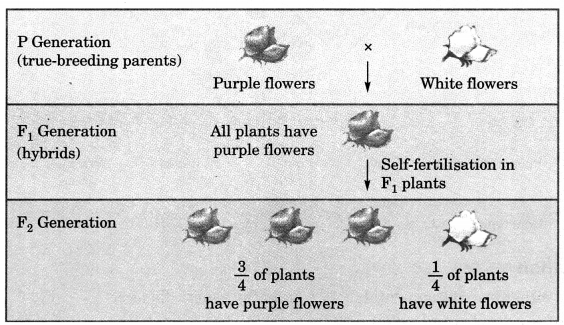
8. Dihybrid Cross: A cross made between two plants having two pairs of contrasting characters is called dihybrid cross.
9. Observations:
- When pea plant with round-yellow seeds (RRYY) was crossed with wrinkled-green seeds (rryy), all the progeny obtained in F1 generation was RrYy (round and yellow seeds).
- Self pollination of F1 plants (RrYy) gave the phenotypic ratio of 9 : 3 : 3 : 1 for round-yellow, round- j green, wrinkled-yellow and wrinkled-green pea seeds respectively.
10. Conclusions:
- Round and yellow seeds are dominant characters.
- Occurrence of new phenotypic combinations shows that genes for round and yellow seeds are inherited independently of each other.
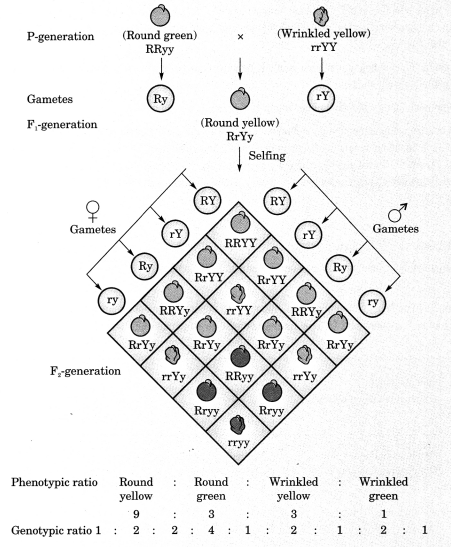
11. Sex Determination
Sex is determined either by environmental factors or by the genetic factors.
Determination of sex due to environmental factors: In some animals, the temperature at which fertilised eggs are kept determines whether the animals developing in the eggs will be male or female. For example, Turtle.
In other animals, such as snails, individuals can change sex, indicating that sex is not genetically determined.
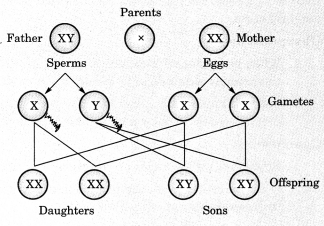
Determination of sex due to genetical factors:
In human beings, the sex of the individual is largely genetically determined. The genes inherited from parents decide the sex of the child. Sex is determined by a pair of chromosome called sex chromosome.
In human beings there are 23 pairs of chromosomes.
Out of these 22 pairs are called autosomes and the last pair of chromosomes that help in deciding gender of that individual are called sex chromosome. Females have XX as sex chromosome while males have XY as sex chromosome.
A cross between a male with XY sex chromosomes and a female with XX as sex chromosome shows that half the children will be boys and half will be girls. All children will inherit an X chromosome from their mother regardless whether they are boys or girls. Thus sex of children will be determined by what they inherit from their father, and not from their mother.
12. Evolution
The process by which different kinds of living organism have developed from earlier life forms during the history of the Earth is called evolution. The essence of idea of evolution is the change in the frequency of certain genes in a population over generations.
Situation I shows Natural Selection: A group of twelve red beetles living in bushes with green leaves are easily spotted by their predator crows. So, red colour does not have any selective advantage in bushes with green beetles than red ones in the beetle population. Hence due to natural selection, the green beetles have better survival chances in green colour bushes. Thus natural selection directs evolution in this case.
Situation II shows Genetic Drift: In the second situation also red coloured beetle live in bushes with leaves. Variations arise as the beetles reproduce sexually and one beetle that is green in colour is produced which has selective advantage in green coloured bushes as crows cannot spot it easily. This beetle passes the colour on to its progeny, so that all its progeny beetles are green. The progeny of green beetles is not eaten, while the progeny of red beetles continues to be eaten. As a result, there are more and more green
which kill the red beetles but leaves the blue beetles. The blue beetles which survive increase in numbers. Though blue colour does not have survival advantage in green coloured bushes, still it survives accidentally or by chance. Such situation where change in the frequency of some genes arises accidentally or by chance without any survival advantage is called genetic drift.
green coloured leaves, are easily spotted and eaten by crows. A colour variation arises during reproduction i and results in a beetle that is blue in colour. This beetle passes the blue colour on to its progeny, so that all its progeny beetles are blue which are again easily spotted in the green coloured bushes by the crows like the red ones. There are a few blue beetles, but most are red. An elephant comes by and stamps on the bushes
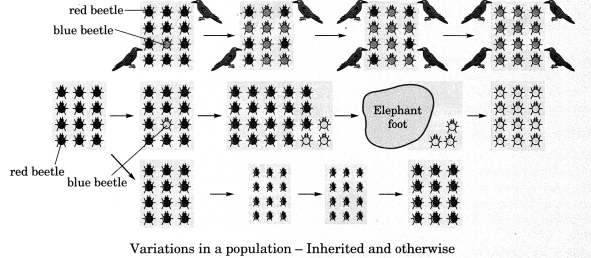
the bushes start suffering from a plant disease due to which the beetles are poorly nourished as the amount of leaf material for the beetles is reduced. No genetic change occurs but the average weight of the beetles.
Situation III shows the effect of availability of resources: The beetle population begins to expand but gets decreased. After a few years when the plant disease gets eliminated the average weight of the beetle increases again as lot of leaf food is available.
Mechanism of heredity: A section of DNA called genes present on chromosome provides information for the synthesis of proteins. Proteins control the formation of a character.
Acquired and Inherited Traits
Inherited traits: The traits which are passed on from the parents to their progeny by transfer of genes. For example, Eye colour.
Acquired traits: The traits acquired by individual during its lifetime. For example, Riding a bicycle, playing cricket, etc.
13. Speciation
The process of formation of new species from the existing species is called speciation. The factors which lead to the formation of new species are:
(i) Reproductive Isolation:
- Allopatric speciation: Caused by the various types of barriers like mountain ranges, rivers, seas, etc. It leads to reproductive isolation between members of the species and this is also called geographical isolation.
- Sympatric speciation: It occurs when populations of a species that share the same habitat become reproductively isolated from each other.
(ii) Genetic drift: It is caused by change in the frequency of particular genes by accident or by chance alone.
(iii) Natural selection: The process by which a group of organisms adopts to fit their environment in a better way.
(iv) Migration: When movement of a section of population to another place and population occurs.
(v) Mutation: Sudden changes in the sequence of DNA.
14. Evidences for Evolution
Homologous organs: Organs having the same basic structure but different functions are called homologous organs. They have a common origin (common ancestor). Example: Forelimbs of man, a lizard, a frog, elephant tusk and a bird have the same basic structure and design but perform different functions.
15. Analogous organs: Organs which perform the same function but have different basic structure are called as analogous organs. They have a different origin (different ancestors).
Example: the wings of insect and the wings of bird have different structure but perform the same function of flying.
16. Fossils: The remains or impressions of the dead animals or plants that lived in the remote past are called fossils.
17. Estimation of age of Fossils: There are two ways to estimate the age of the fossils:
18. Relative method: On digging the Earth, the fossils we find closer to the surface are more recent than the fossils we find in deeper layers.
19. Carbon-dating method: By detecting radioactivity of Carbon-14 isotope left in the fossil.
20. Evolution by Stages
Evolution of eye: The complex body designs have been created in stages over many generations. The flatworm named Planaria has very simple ‘eyes’ that are just eye-spots which detect light. But later on more complex eyes evolved in various organisms from them.
(i) Evolution of feathers: Evolutionary change produced in an organism for one purpose became more useful for a different function. Feathers first arose for insulation in cold weather but later they became more useful for flying.
(ii) Evolution by artificial selection: Evolution of wild cabbage is an example of evolution by artificial selection. Humans, cultivated wild cabbage as a food plant, and generated different vegetables from it by artificial selection.
| Character Selected | Variety Selected |
| Very shot distances between leaves | Cabbage |
| Arrested flower development | Broccoli |
| Sterile flowers | Cauliflower |
| Swollen parts | Kohlrabi |
| Slightly larger leaves | Kale |
21. Evolution should not be equated with ‘progress’: Natural selection and genetic drift cause evolution but that does not mean that
- one species is eliminated to form the new one, or
- the new species is better than the older one. So, evolution should not be equated with progress as multiple branches are possible at each and every stage of evolution.
Example: Human beings have not evolved from chimpanzees. Both have evolved in their own separate ways from a common ancestor a long time ago.
Only progressive trend in evolution: More and more complex body designs have emerged overtime. The older forms still survive along with the newer forms. Example: Bacteria are most primitive forms which are able to survive even in harsh habitats like hot springs or polar ice caps.
22. Human Evolution
Tools for tracing evolutionary relationships: Excavating, time-dating, studying fossils and determining DNA sequences. These tools have been used to study human evolution. Due to different forms and features of human were distinguished on the basis of skin colours into various races. But evidence points out that all human beings are a single species and there is no biological notion of human races.
Earliest members of human species (Homo sapiens) came from Africa. Some of our ancestors stayed back in Africa while others moved and spread across to West Asia, Central Asia, Eurasia, South Asia, and East Asia. They moved from the islands of Indonesia and the Philippines to Australia, and some crossed the Bering land bridge to reach the Americas. They did not go in a single line but went forwards and backwards, with groups sometimes separating from each other, sometimes coming back to mix with each other, even moving in and out of Africa.
Class 10 Science Chapter 9 Notes Important Terms
Heredity: Transmission of characters/traits from parents to their offspring, either through asexual reproduction or sexual reproduction.
Variation: The degree by which progeny differ from their parents.
Inheritance: It is the process by which characters are passed on from parent to progeny. Monohybrid cross: Cross between two pea plants for one pair of contrasting trait of a character.
Dihybrid cross: A cross made between two plants having two pairs of contrasting characters is called dihybrid cross.
Evolution: The process by which different kinds of living organism have developed from earlier life forms during the history of the Earth.
Inherited traits: The traits which are passed on from the parents to their progeny by transfer of genes. For example, Eye colour.
Acquired traits: The traits acquired by individual during its lifetime. For example, Riding a bicycle, playing cricket, etc.
Speciation: The process of formation of new species from the existing species is called speciation. Homologous organs: Organs having the same basic structure but different functions are called as homologous organs. They have a common origin (common ancestor).
Example: Forelimbs of man, a lizard, a frog and a bird have the same basic structure and design but perform different functions.
Analogous organs: Organs which perform the same function but have different basic structure are called as analogous organs. They have a different origin (different ancestors).
Example: The wings of insect and the wings of bird have different structure but perform the same function of flying.
Mutation: Sudden changes in the sequence of DNA.
Sympatric speciation: It occurs when populations of a species that share the same habitat become reproductively isolated from each other.
Allopatric speciation: Speciation caused by the various types of barriers like mountain ranges, rivers, seas, etc.
Fossils: The remains or impressions of the dead animals or plants that lived in the remote past are called as fossils.